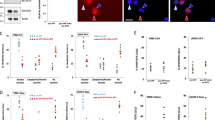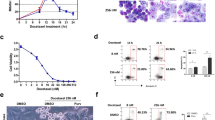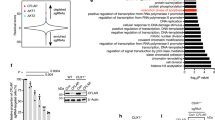Abstract
One of the pivotal functions of endogenous tumor suppression is to oppose aberrant cell survival, but the molecular requirements of this process are not completely understood. Here, we show that caspase 2, a death effector with largely unknown functions, represses transcription of the survivin gene, a general regulator of cell division and cytoprotection in tumors. This pathway involves caspase 2 proteolytic cleavage of the nuclear factor κB (NFκB) activator, RIP1. In turn, loss of RIP1 abolishes transcription of NFκB target genes, including survivin, resulting in deregulated mitotic transitions, enhanced apoptosis and suppression of tumorigenicity in vivo. Therefore, caspase 2 functions as an endogenous inhibitor of NFκB-dependent cell survival and this mechanism may contribute to tumor suppression in humans.
This is a preview of subscription content, access via your institution
Access options
Subscribe to this journal
Receive 50 print issues and online access
$259.00 per year
only $5.18 per issue
Buy this article
- Purchase on Springer Link
- Instant access to full article PDF
Prices may be subject to local taxes which are calculated during checkout









Similar content being viewed by others
References
Accili D, Arden KC . (2004). FoxOs at the crossroads of cellular metabolism, differentiation, and transformation. Cell 117: 421–426.
Altieri DC . (2008). Survivin, cancer networks and pathway-directed drug discovery. Nat Rev Cancer 8: 61–70.
Anand P, Kunnumakkara AB, Harikumar KB, Ahn KS, Badmaev V, Aggarwal BB . (2008). Modification of cysteine residue in p65 subunit of nuclear factor-kappaB (NF-kappaB) by picroliv suppresses NF-kappaB-regulated gene products and potentiates apoptosis. Cancer Res 68: 8861–8870.
Baptiste-Okoh N, Barsotti AM, Prives C . (2008). A role for caspase 2 and PIDD in the process of p53-mediated apoptosis. Proc Natl Acad Sci USA 105: 1937–1942.
Bergeron L, Perez GI, Macdonald G, Shi L, Sun Y, Jurisicova A et al. (1998). Defects in regulation of apoptosis in caspase-2-deficient mice. Genes Dev 12: 1304–1314.
Bouchier-Hayes L, Oberst A, McStay GP, Connell S, Tait SW, Dillon CP et al. (2009). Characterization of cytoplasmic caspase-2 activation by induced proximity. Mol Cell 35: 830–840.
Castedo M, Perfettini JL, Roumier T, Valent A, Raslova H, Yakushijin K et al. (2004). Mitotic catastrophe constitutes a special case of apoptosis whose suppression entails aneuploidy. Oncogene 23: 4362–4370.
Cory S, Adams JM . (2002). The Bcl2 family: regulators of the cellular life-or-death switch. Nat Rev Cancer 2: 647–656.
Du C, Fang M, Li Y, Li L, Wang X . (2000). Smac, a mitochondrial protein that promotes cytochrome c-dependent caspase activation by eliminating IAP inhibition. Cell 102: 33–42.
Fesik SW . (2005). Promoting apoptosis as a strategy for cancer drug discovery. Nat Rev Cancer 5: 876–885.
Festjens N, Vanden Berghe T, Cornelis S, Vandenabeele P . (2007). RIP1, a kinase on the crossroads of a cell′s decision to live or die. Cell Death Differ 14: 400–410.
Ghosh JC, Dohi T, Kang BH, Altieri DC . (2008). Hsp60 regulation of tumor cell apoptosis. J Biol Chem 283: 5188–5194.
Guha M, Plescia J, Leav I, Li J, Languino LR, Altieri DC . (2009). Endogenous tumor suppression mediated by PTEN involves survivin gene silencing. Cancer Res 69: 4954–4958.
Ho LH, Read SH, Dorstyn L, Lambrusco L, Kumar S . (2008). Caspase-2 is required for cell death induced by cytoskeletal disruption. Oncogene 27: 3393–3404.
Ho LH, Taylor R, Dorstyn L, Cakouros D, Bouillet P, Kumar S . (2009). A tumor suppressor function for caspase-2. Proc Natl Acad Sci USA 106: 5336–5341.
Hoffman WH, Biade S, Zilfou JT, Chen J, Murphy M . (2002). Transcriptional repression of the anti-apoptotic survivin gene by wild type p53. J Biol Chem 277: 3247–3257.
Janssens S, Tinel A, Lippens S, Tschopp J . (2005). PIDD mediates NF-kappaB activation in response to DNA damage. Cell 123: 1079–1092.
Jiang Y, Saavedra HI, Holloway MP, Leone G, Altura RA . (2004). Aberrant regulation of survivin by the RB/E2F family of proteins. J Biol Chem 279: 40511–40520.
Kang BH, Altieri DC . (2006). Regulation of survivin stability by the aryl hydrocarbon receptor-interacting protein. J Biol Chem 281: 24721–24727.
Karin M . (2006). Nuclear factor-[kappa]B in cancer development and progression. Nature 441: 431–436.
Kawakami H, Tomita M, Matsuda T, Ohta T, Tanaka Y, Fujii M et al. (2005). Transcriptional activation of survivin through the NF-kappaB pathway by human T-cell leukemia virus type I tax. Int J Cancer 115: 967–974.
Krumschnabel G, Sohm B, Bock F, Manzl C, Villunger A . (2009). The enigma of caspase-2: the laymen's view. Cell Death Differ 16: 195–207.
Lamkanfi M, D'Hondt K, Vande Walle L, van Gurp M, Denecker G, Demeulemeester J et al. (2005). A novel caspase-2 complex containing TRAF2 and RIP1. J Biol Chem 280: 6923–6932.
Lee CW, Raskett CM, Prudovsky I, Altieri DC . (2008). Molecular dependence of estrogen receptor-negative breast cancer on a notch-survivin signaling axis. Cancer Res 68: 5273–5281.
Li F, Altieri DC . (1999). Transcriptional analysis of human survivin gene expression. Biochem J 344 (Pt 2): 305–311.
Li H, Bergeron L, Cryns V, Pasternack MS, Zhu H, Shi L et al. (1997). Activation of caspase-2 in apoptosis. J Biol Chem 272: 21010–21017.
Li J, Yuan J . (2008). Caspases in apoptosis and beyond. Oncogene 27: 6194–6206.
Lin Y, Devin A, Rodriguez Y, Liu ZG . (1999). Cleavage of the death domain kinase RIP by caspase-8 prompts TNF-induced apoptosis. Genes Dev 13: 2514–2526.
Lowe SW, Cepero E, Evan G . (2004). Intrinsic tumour suppression. Nature 432: 307–315.
Luo J, Solimini NL, Elledge SJ . (2009). Principles of cancer therapy: oncogene and non-oncogene addiction. Cell 136: 823–837.
Makishi S, Okudaira T, Ishikawa C, Sawada S, Watanabe T, Hirashima M et al. (2008). A modified version of galectin-9 induces cell cycle arrest and apoptosis of Burkitt and Hodgkin lymphoma cells. Br J Haematol 142: 583–594.
Mhaidat NM, Wang Y, Kiejda KA, Zhang XD, Hersey P . (2007). Docetaxel-induced apoptosis in melanoma cells is dependent on activation of caspase-2. Mol Cancer Ther 6: 752–761.
Micheau O, Tschopp J . (2003). Induction of TNF receptor I-mediated apoptosis via two sequential signaling complexes. Cell 114: 181–190.
Mirza A, McGuirk M, Hockenberry TN, Wu Q, Ashar H, Black S et al. (2002). Human survivin is negatively regulated by wild-type p53 and participates in p53-dependent apoptotic pathway. Oncogene 21: 2613–2622.
Mita AC, Mita MM, Nawrocki ST, Giles FJ . (2008). Survivin: key regulator of mitosis and apoptosis and novel target for cancer therapeutics. Clin Cancer Res 14: 5000–5005.
O′Connor DS, Grossman D, Plescia J, Li F, Zhang H, Villa A et al. (2000). Regulation of apoptosis at cell division by p34cdc2 phosphorylation of survivin. Proc Natl Acad Sci USA 97: 13103–13107.
Rebe C, Cathelin S, Launay S, Filomenko R, Prevotat L, L'Ollivier C et al. (2007). Caspase-8 prevents sustained activation of NF-kappaB in monocytes undergoing macrophagic differentiation. Blood 109: 1442–1450.
Shi M, Vivian CJ, Lee KJ, Ge C, Morotomi-Yano K, Manzl C et al. (2009). DNA-PKcs-PIDDosome: a nuclear caspase-2-activating complex with role in G2/M checkpoint maintenance. Cell 136: 508–520.
Shi Y . (2002). Mechanisms of caspase activation and inhibition during apoptosis. Mol Cell 9: 459–470.
Shin MS, Kim HS, Kang CS, Park WS, Kim SY, Lee SN et al. (2002). Inactivating mutations of CASP10 gene in non-Hodgkin lymphomas. Blood 99: 4094–4099.
Soung YH, Lee JW, Kim SY, Park WS, Nam SW, Lee JY et al. (2004). Somatic mutations of CASP3 gene in human cancers. Hum Genet 115: 112–115.
Srinivasula SM, Ashwell JD . (2008). IAPs: what's in a name? Mol Cell 30: 123–135.
Stupack DG, Teitz T, Potter MD, Mikolon D, Houghton PJ, Kidd VJ et al. (2006). Potentiation of neuroblastoma metastasis by loss of caspase-8. Nature 439: 95–99.
Tinel A, Janssens S, Lippens S, Cuenin S, Logette E, Jaccard B et al. (2007). Autoproteolysis of PIDD marks the bifurcation between pro-death caspase-2 and pro-survival NF-kappaB pathway. EMBO J 26: 197–208.
Tinel A, Tschopp J . (2004). The PIDDosome, a protein complex implicated in activation of caspase-2 in response to genotoxic stress. Science 304: 843–846.
Troy CM, Shelanski ML . (2003). Caspase-2 redux. Cell Death Differ 10: 101–107.
Upton JP, Austgen K, Nishino M, Coakley KM, Hagen A, Han D et al. (2008). Caspase-2 cleavage of BID is a critical apoptotic signal downstream of endoplasmic reticulum stress. Mol Cell Biol 28: 3943–3951.
Vaira V, Lee CW, Goel HL, Bosari S, Languino LR, Altieri DC . (2007). Regulation of survivin expression by IGF-1/mTOR signaling. Oncogene 26: 2678–2684.
Van de Craen M, Declercq W, Van den brande I, Fiers W, Vandenabeele P . (1999). The proteolytic procaspase activation network: an in vitro analysis. Cell Death Differ 6: 1117–1124.
Vogelstein B, Lane D, Levine AJ . (2000). Surfing the p53 network. Nature 408: 307–310.
Wang D, Baldwin Jr AS . (1998). Activation of nuclear factor-kappa b-dependent transcription by tumor necrosis factor-alpha is mediated through phosphorylation of RelA/p65 on Serine 529. J Biol Chem 273: 29411–29416.
Wang RH, Zheng Y, Kim HS, Xu X, Cao L, Luhasen T et al. (2008). Interplay among BRCA1, SIRT1, and Survivin during BRCA1-associated tumorigenesis. Mol Cell 32: 11–20.
Wheatley SP, Barrett RM, Andrews PD, Medema RH, Morley SJ, Swedlow JR et al. (2007). Phosphorylation by Aurora-B negatively regulates survivin function during mitosis. Cell Cycle 6: 1220–1230.
Xia F, Altieri DC . (2006). Mitosis-independent survivin gene expression in vivo and regulation by p53. Cancer Res 66: 3392–3395.
Yeung BH, Huang DC, Sinicrope FA . (2006). PS-341 (bortezomib) induces lysosomal cathepsin B release and a caspase-2-dependent mitochondrial permeabilization and apoptosis in human pancreatic cancer cells. J Biol Chem 281: 11923–11932.
You L, He B, Xu Z, Uematsu K, Mazieres J, Fujii N et al. (2004). An anti-Wnt-2 monoclonal antibody induces apoptosis in malignant melanoma cells and inhibits tumor growth. Cancer Res 64: 5385–5389.
Zhou J, Bi C, Janakakumara JV, Liu SC, Chng WJ, Tay KG et al. (2009). Enhanced activation of STAT pathways and overexpression of survivin confer resistance to FLT3 inhibitors and could be therapeutic targets in AML. Blood 113: 4052–4062.
Acknowledgements
We thank Drs Bert Vogelstein, Michelle Kelliher and Neal Silverman for reagents. This work was supported by the National Institutes of Health grants CA78810, CA90917 and CA118005.
Author information
Authors and Affiliations
Corresponding author
Rights and permissions
About this article
Cite this article
Guha, M., Xia, F., Raskett, C. et al. Caspase 2-mediated tumor suppression involves survivin gene silencing. Oncogene 29, 1280–1292 (2010). https://doi.org/10.1038/onc.2009.428
Received:
Revised:
Accepted:
Published:
Issue Date:
DOI: https://doi.org/10.1038/onc.2009.428
Keywords
This article is cited by
-
NF-κB suppresses apoptosis and promotes bladder cancer cell proliferation by upregulating survivin expression in vitro and in vivo
Scientific Reports (2017)
-
Caspase-2: an orphan enzyme out of the shadows
Oncogene (2017)
-
Caspase-2 promotes obesity, the metabolic syndrome and nonalcoholic fatty liver disease
Cell Death & Disease (2016)
-
Oncoapoptotic Markers in Oral Cancer: Prognostics and Therapeutic Perspective
Molecular Diagnosis & Therapy (2014)
-
Targeting Survivin in Cancer: Novel Drug Development Approaches
BioDrugs (2014)



